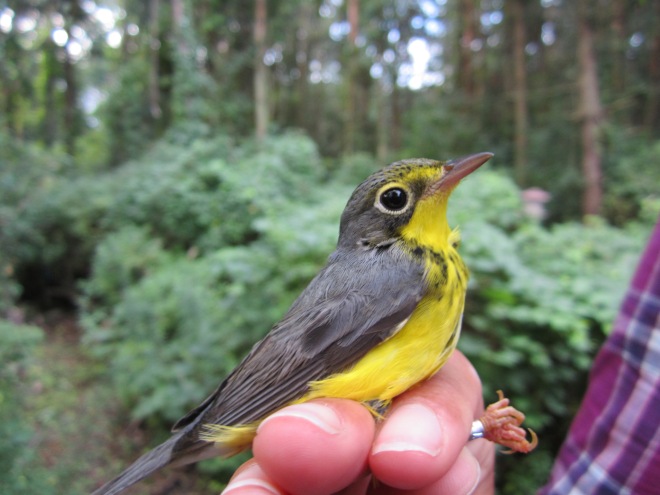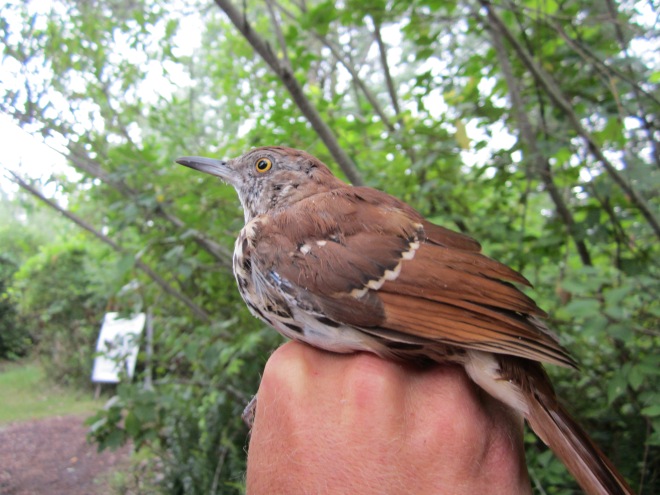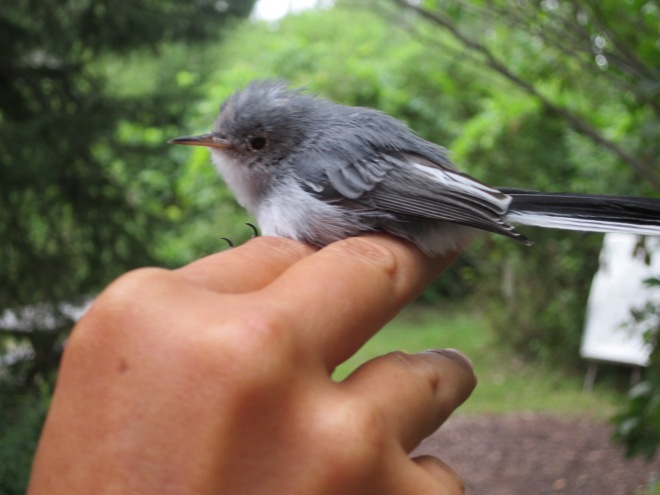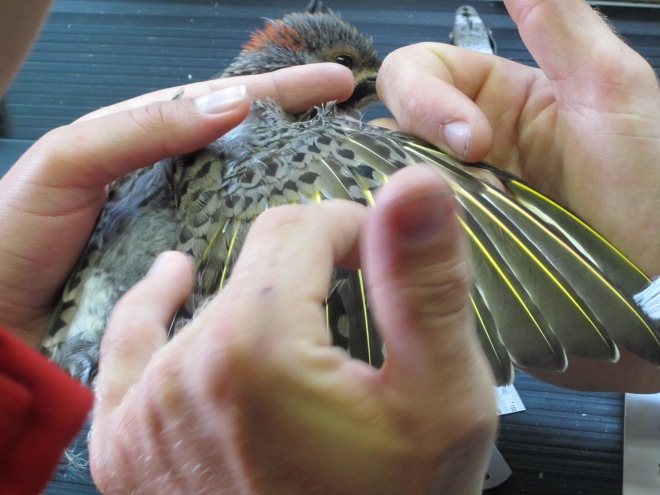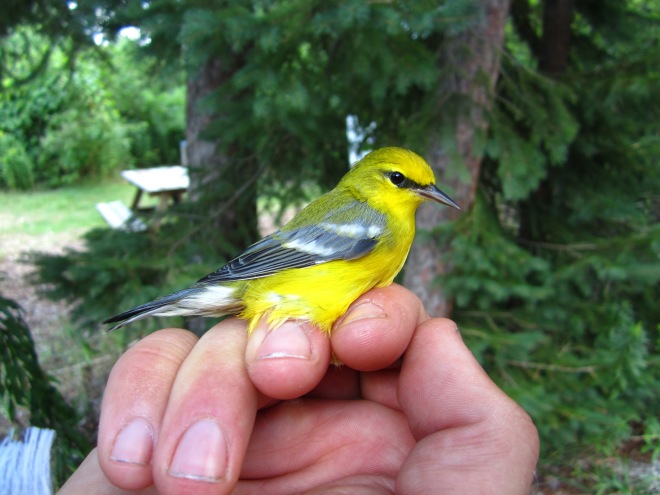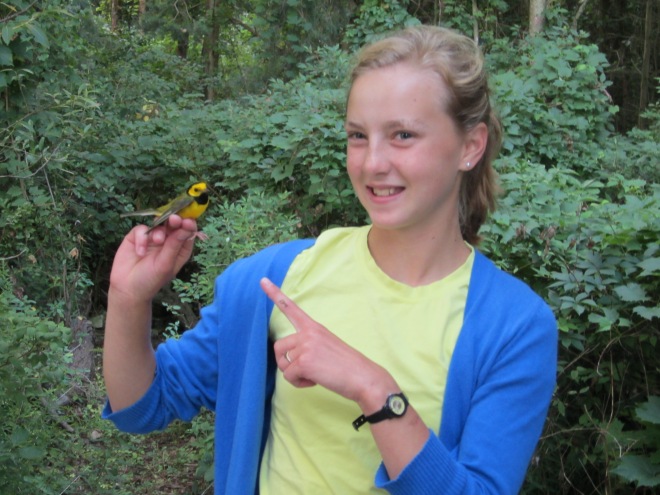(Part 1 of my internship account is here)
September 1st: It was a little windy today, so some of the nets were closed, but we caught a hatch-year female Sharp-shinned Hawk which was very neat! An after-hatch year male and female Canada Warblers were caught in the same net. It was a good opportunity see the differences in plumage in the hand, and side by side. There weren’t very many songbirds around, but I did find a Magnolia Warbler, American Redstart, and a Wilson’s Warbler flitting about in some bushes near one of the nets.
A female Sharp-shinned Hawk,
The after-hatch year male and female Canada Warblers,
We saw a few Ospreys at the Tip, and this one was very obliging for a photograph,
September 4th: Today was the only day we banded over 100 birds while I was at the Tip. It was a lot of fun to see so many birds but it was also very tiring for the banders. Most of the birds caught were Catharus thrushes, Blackpoll Warblers, a Wood Thrush, and other species, and a Connecticut Warbler was also banded later in the morning. There were hundreds of Red-winged Blackbirds flying over with a few Bobolinks in the mix, and there were 25 Sanderling feeding along the beach.
A Connecticut Warbler,
A Viceroy Butterfly,
LPBO staffer Janice with a male Indigo Bunting (and matching shirt and fingernails!),
September 5th: Today wasn’t as busy as yesterday for banding, but the number of warblers moving through the area was astounding! Some of the warbler species were Wilson’s Warblers, Black-throated Green Warblers, Canada Warblers, Blackpoll Warblers, Nashville Warblers, Bay-breasted Warblers, Northern Parulas, Black-throated Blue Warblers, Chestnut-sided Warblers, Magnolia Warblers, and Cape May Warblers were all seen around the Tip. In the afternoon Ana, Antje, Daniel, and I did a supplementary census and the highlights were a large mixed flock of 16 warbler species, a Brown Thrasher, a Baird’s Sandpiper feeding in a group with three Least Sandpipers, a Cooper’s Hawk, and a very co-operative Philadelphia Vireo. My two lifers for the day were the Philadelphia Vireo and Northern Parula.
A Bay-breasted Warbler,
Northern Parula,
September 8th: It was much too windy to open any of the nets today, so in the early morning Dayna, Ana, and I went out to the Tip to look for any unusual gulls and Jaegers that would have been brought in by the strong winds; unfortunately we didn’t see any. We did see over 4,000 Double-crested Cormorants flying past the Tip which was quite the spectacle. There were three Great Black-backed Gulls at the Tip and large flocks of Sanderlings were flying around with a Baird’s Sandpiper and two Semipalmated Plovers mixed in.
A beautiful Pandora’s Sphinx Moth,
A Monarch Butterfly chrysalis I found in the sand at the Tip,
September 9th: Bird activity is still very slow and since it wasn’t too windy we were able to open some of the nets. Double-crested Cormorants were flying past the Tip in large numbers, and a Great Blue Heron was hunting along the shore of the Tip. On one of my net rounds, I saw a banded Rock Pigeon sitting on the Heligoland Trap. Some of my favorites banded today were a Tennessee Warbler, Chestnut-sided Warbler, Red-eyed Vireo, Magnolia Warblers, and Blackpoll Warblers.
Tennessee Warbler ruffled from the wind,
A male Chestnut-sided Warbler,
Sunrise at the Tip,
LPBO staffer Dayna with a Black-throated Blue Warbler,
One of my favorite warbler species — a male Black-throated Blue Warbler,
A very ratty looking moulting Eastern Towhee,
Eastern Whip-poor-Will,
September 11th: Swainson’s Thrushes, Gray-cheeked Thrushes, Veerys, Wilson’s Warblers, American Redstarts, Red-eyed Vireos, and American Robins were some of the species caught this morning. The best bird of the day was an immature male Eastern Towhee. Stu and Ed were on census, but about half an hour into the census Ed came running back to tell the rest of us at the banding station that they had found an Upland Sandpiper in a tree. It was really interesting to see the sandpiper just standing on a branch high up in a tree.
An Upland Sandpiper,
September 14th: Banding was steady this morning with LPBO’s first Orange-crowned Warbler of the Fall season and lots of Swainson’s Thrushes. I was able to band a Wood Thrush, many Black-throated Blue Warblers, and American Redstarts. There were lots of American Redstarts in the woodlot around Old Cut and many of them were adult males instead of the usual females and immature males. In the late morning, someone who was birding around Old Cut found an Eastern Whip-poor Will roosting in a spruce tree, it was a great way to end my stay at Long Point!
Late in the afternoon of the 14th I left Long Point and got on a plane in Hamilton to fly back home to Alberta.
During my month stay at Long Point, I read the first 40 pages of Peter Pyle’s Identification Guide to North American Birds, Part II which is essential to bird banding; there are copies of both volumes in all the LPBO banding labs and library. From my banding work and the book, I learned a lot this summer about skull ossification and molt patterns. I also learned just how much work is put in by volunteers, from entering data, and bleaching the walls of the house at the Tip to keep molt and spider droppings from wrecking the paint, to sweeping all the sand out of the house daily and installing a new refrigerator. Without all the hard work done by volunteers, the Long Point Bird Observatory wouldn’t run as smoothly as it does.
I had so much fun at Long Point again and learned so much. I hope to go back sometime soon!
The species I was able to add to my Life List at Long Point, August-September 2013:
Eastern Whip-poor Will, Upland Sandpiper, Philadelphia Vireo, Northern Parula, Wood Thrush, Gray-cheeked Thrush, Bay-breasted Warbler, Nashville Warbler, Blackpoll Warbler, Acadian Flycatcher, Palm Warbler, Peregrine Falcon, Wilson’s Warbler, Connecticut Warbler, Prairie Warbler, Yellow-billed Cuckoo, Ovenbird, Black-throated Green Warbler, Black-throated Blue Warbler, Cape May Warbler, Black-billed Cuckoo, Virginia Rail, and Magnolia Warbler.






















